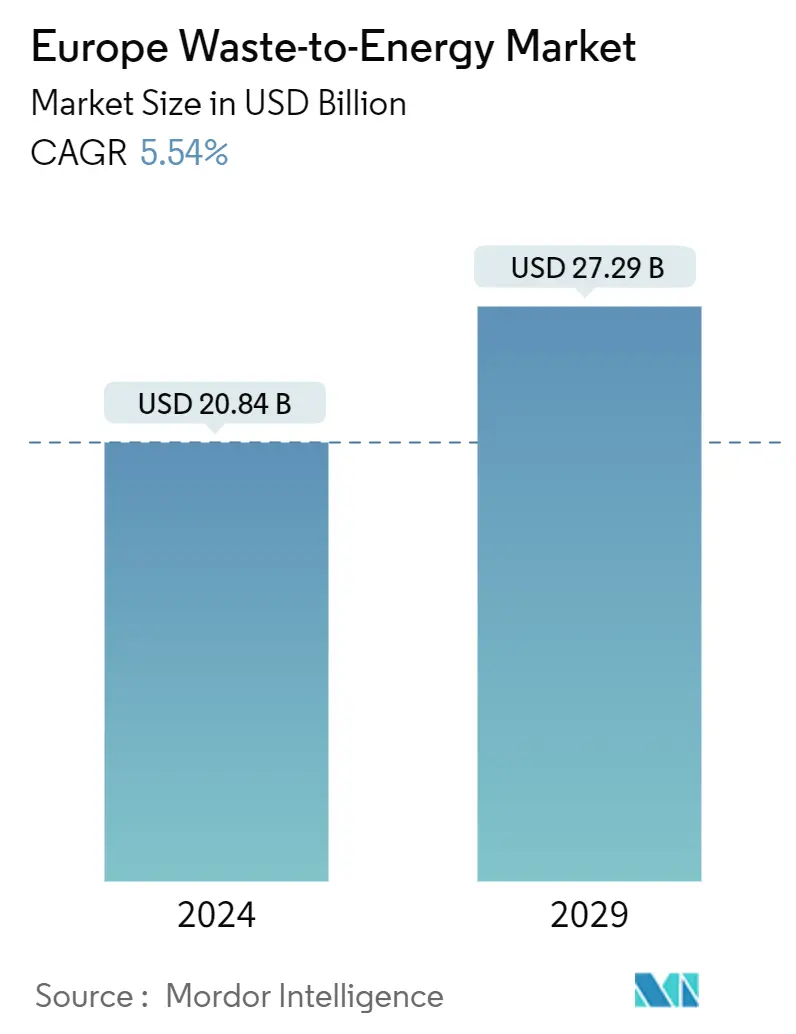Market Size of Europe Waste-to-Energy Industry

| Study Period | 2019-2029 |
| Base Year For Estimation | 2023 |
| Market Size (2024) | USD 20.84 Billion |
| Market Size (2029) | USD 27.29 Billion |
| CAGR (2024 - 2029) | 5.54 % |
| Market Concentration | Medium |
Major Players.webp)
*Disclaimer: Major Players sorted in no particular order |
Europe Waste-to-Energy Market Analysis
The Europe Waste-to-Energy Market size is estimated at USD 20.84 billion in 2024, and is expected to reach USD 27.29 billion by 2029, growing at a CAGR of 5.54% during the forecast period (2024-2029).
Over the medium term, factors such as the increasing amount of waste generation, growing concern for waste management to meet the need for sustainable urban living, and rising focus on non-fossil fuel sources of energy are likely to drive the demand for waste-to-energy in the region.
On the other hand, the market growth is expected to be restrained by the expensive nature of incinerators, as energy prices decline and several plants cannot cover operating costs. Furthermore, several European countries plan to focus more on recycling, which saves three to five times more energy, thus restraining the waste-to-energy market.
Nevertheless, the emerging waste-to-energy technologies, such as Dendro Liquid Energy (DLE), which is four times more efficient in electricity generation, with additional benefits of no emission discharge and effluence problems at plant sites, are expected to create significant opportunities for the market players over the forecast period.
Germany dominated the market across Europe. An increase in municipal waste energy plants and rapid urbanization in the country drive growth.
Europe Waste-to-Energy Industry Segmentation
Waste is any substance or unwanted material that results from any human activity or process. Municipal solid waste generation rates are influenced by economic development, the degree of industrialization, public habits, and local climate. As a general trend, the higher the economic development, the higher the amount of municipal solid waste generated. Waste-to-energy is the process of generating energy in the form of electricity and/or heat through the primary treatment of waste or processing of the same into a fuel source. The technology used for this process includes physical, thermal, and biological technologies.
The European waste-to-energy market is segmented by technology and geography. By technology, the market is segmented into physical, thermal, and biological. The report also covers the market size and forecasts for the waste-to-energy market across major countries, such as Germany, the United Kingdom, Italy, France, and the rest of Europe.
For each segment, the market sizing and forecasts have been done based on revenue (USD).
| Source: https://www.mordorintelligence.com/industry-reports/europe-generator-sets-market | |
| Physical | |
| Biological |
| Country | |
| Germany | |
| United Kingdom | |
| Italy | |
| France | |
| Spain | |
| Nordic Countries | |
| Turkey | |
| Russia | |
| Rest of Europe |
Europe Waste-to-Energy Market Size Summary
The European waste-to-energy (WtE) market is poised for growth, driven by increasing waste generation and a heightened focus on sustainable urban living. The region's commitment to reducing reliance on fossil fuels further propels the demand for WtE solutions. However, the market faces challenges due to the high costs associated with incineration technologies and the growing emphasis on recycling, which offers more energy savings. Despite these challenges, advancements in WtE technologies, such as Dendro Liquid Energy, present significant opportunities for market players. Germany leads the market, fueled by rapid urbanization and the expansion of municipal waste energy plants, while Italy is also making strides in integrating WtE facilities with other technologies to enhance energy recovery.
Thermal processes, including incineration, gasification, and pyrolysis, dominate the WtE market in Europe, with incineration being the most recognized method for processing municipal solid waste. While incineration offers higher electrical efficiency, it also raises environmental concerns due to emissions. Gasification is preferred for its lower emissions per unit of power generated. The market is moderately fragmented, with key players like Mitsubishi Heavy Industries, Veolia Environnement, and Hitachi Zosen Corp. actively participating. Recent developments, such as Fortum's expansion in the UK and Rome's new incinerator project, highlight ongoing efforts to innovate and expand WtE capabilities in Europe.
Europe Waste-to-Energy Market Size - Table of Contents
-
1. MARKET OVERVIEW
-
1.1 Introduction
-
1.2 Market Size and Demand in USD billion, till 2029
-
1.3 Recent Trends and Developments
-
1.4 Government Policies and Regulations
-
1.5 Market Dynamics
-
1.5.1 Drivers
-
1.5.1.1 Government Focus on Waste Management
-
1.5.1.2 Decline in Fossil-fuel based Electricity Generation
-
-
1.5.2 Restraints
-
1.5.2.1 High Price of Incinerators and Decline in Energy Price of Other Renewable Energy Sources
-
-
-
1.6 Supply Chain Analysis
-
1.6.1 Porter's Five Forces Analysis
-
1.6.2 Bargaining Power of Suppliers
-
1.6.3 Bargaining Power of Consumers
-
1.6.4 Threat of New Entrants
-
1.6.5 Threat of Substitutes Products and Services
-
1.6.6 Intensity of Competitive Rivalry
-
-
-
2. MARKET SEGMENTATION
-
2.1 Thermal
-
2.2 Source: https://www.mordorintelligence.com/industry-reports/europe-generator-sets-market
-
2.2.1 Physical
-
2.2.2 Biological
-
-
2.3 Country
-
2.3.1 Germany
-
2.3.2 United Kingdom
-
2.3.3 Italy
-
2.3.4 France
-
2.3.5 Spain
-
2.3.6 Nordic Countries
-
2.3.7 Turkey
-
2.3.8 Russia
-
2.3.9 Rest of Europe
-
-
Europe Waste-to-Energy Market Size FAQs
How big is the Europe Waste-to-Energy Market?
The Europe Waste-to-Energy Market size is expected to reach USD 20.84 billion in 2024 and grow at a CAGR of 5.54% to reach USD 27.29 billion by 2029.
What is the current Europe Waste-to-Energy Market size?
In 2024, the Europe Waste-to-Energy Market size is expected to reach USD 20.84 billion.

